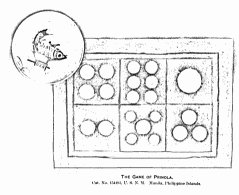
Pat chá, "grasping eight," is played with 8 dice, preferably of the smallest size. In this game the banker is provided with a diagram (Figure 2) numbered or dotted, like the 6 faces of a die, upon which the [Page 496] players place their stakes. It bears the legend pat t'ung, "unlike," which expresses the desire of the banker as to the manner in which the dice shall fall.
A player throws 8 dice. If at least 3 fall like the number bet on, the gamekeeper pays him 8 times, or if 6 or more are like the number bet on, 16 times the amount of his stakes. In any other event, the player loses.

A similarly marked tablet is used in playing with the ch'é mé, or teetotum (Figure 3). This implement is made with 6 dotted sides. The players lay their stakes upon the numbers on the tablet, and win 4 times the amount of their stakes if the one played on turns uppermost, or lose, if another number comes up.
The ch'é mé is said to have its sides decorated sometimes with pictures of fish and animals instead of numbers or spots, and the diagram, which is called the ch'é me p'ai, or the "tablet for the teetotum," is then similarly inscribed (Figure 3).1

Notes: 1. A similar game from Manila, Philippine Islands, in the United States National Museum (Plate 2), consists of a cardboard with 6 equal divisions, with numbers, represented by disks of colored paper, from 1 to 6; a hexagon-shaped top with numbers from 1 to 6, and a saucer in which to spin it. It is described by the collector, Hon. Alex. R. Webb, United States Consul, under the name of prinola, as a popular game in the marketplaces with the native women.
"Bets are placed on the spots on the board, the top is spun rapidly in the saucer, and the winners are paid double the amount of their bets. Only one number can win, of course the one corresponding to that which turns up when the top stops turning, and the chances are therefore quite largely in favor of the dealer."
The name is evidently the Portuguese pirinola, but the game is probably of Chinese or Indian origin. In India a 6-sided teetotum, chukree, identical with the Chinese, is used, and is turned like a top on a wooden or china plate. "The stakes are placed on a board with 6 partitions, and the game is decided on the settling of the die with a particular number uppermost. The play of this game is allowed only during the Diwali festival, when gambling is sanctioned as a religious observance." (Ms. catalogue of Indian games and toys procured for the Chicago exhibition, Provincial Museum, Lucknow, India.)
Last update January 31, 2010